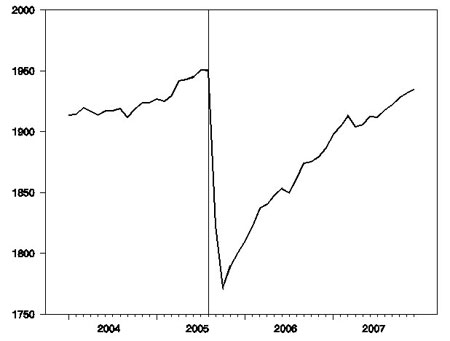As the eastern U.S. tries to dig out from under the devastation, I thought it might be useful to comment on the economic consequences that a storm like this could have.
One school of thought holds that our economic problems are entirely a deficiency of aggregate demand. According to this view, if we could just get consumers (or the government) to spend more, our problems would be solved. The classic extreme example of a policy that might boost GDP according to this perspective would be if the government were to pay workers to dig a hole and fill it back in.
That extreme case leads one naturally to ask how it could possibly be better to pay people to do dangerous and hard work digging a hole compared to just sending them checks to stay comfortably at home. The answer turns out to be that, if we pay for hole-digging, we not only have provided paychecks to workers, we also have produced a newly-filled-in hole, which the convention of our national income accounts treats as newly-created infrastructure. The economic value of that is taken to be whatever the government paid for it, and thereby adds directly to GDP.
In the present situation, there is a tremendous amount of real work that needs to be done– subways need to be drained, debris needs to be removed, fallen trees need to be cleared. Lots of hard work needed and jobs created in getting that done. More importantly, when the work is finished, we’ll have not a filled-in hole, but instead something really valuable– subways we can ride to work, roads that we can drive on.
Except, we had all those same good things two weeks ago.
In the mean time, trying to get by without those means people who can’t get to work, commissions on financial transactions that won’t be earned, sales that didn’t get made. The Wall Street Journal reports:
Along the East Coast, some restaurants, car dealers and other retailers are likely to see sales slip. Many workers aren’t being paid for lost hours. Shipments of goods through eastern seaports and airports are being delayed….
“It’s not catastrophic but it’s not trivial,” said Gregory Daco, an economist at IHS Global Insight. “You’re seeing major disruptions in trade flows, both on the import and the export side. You’re seeing disruptions in terms of construction, in terms of manufacturing, and also in terms of services—movie theaters closing, your local grocery store may not be open. It’s a number of combined shots that overall affect the U.S. economy.”
Those employed in the New York financial district had been constructively contributing to GDP last week, despite the weak economy. When people in good-paying jobs are prevented from getting to work, it has to be costly in any sensible economic model. This is particularly the case if it takes a long time to get the infrastructure repaired or if alternatives to New York brokers and transporters gain market share as a result of this episode.
One parallel to consider is the devastation from Hurricane Katrina in 2005. In addition to the short-run dislocations, this ended up causing lasting damage to offshore oil-producing infrastructure. An optimist might have thought this would create all kinds of new jobs trying to rebuild. The actual experience was not so cheerful.

Seasonally adjusted nonfarm employment in Louisiana, 2004:M1 – 2007:M12, in thousands of workers. Vertical line marks Hurricane Katrina in August 2005. Data source: BLS.
The Wall Street Journal reports that IHS estimates that Hurricane Sandy could reduce the 2012:Q4 U.S. real GDP growth rate by 0.6 percentage points at an annual rate. I’m not sure how one comes up with that kind of number.
But I am persuaded this was not a good thing for the U.S. economy.
Economic Effects of Hurricane Sandy
- Bulenox: Get 45% to 91% OFF ... Use Discount Code: UNO
- Risk Our Money Not Yours | Get 50% to 90% OFF ... Use Discount Code: MMBVBKSM
Disclaimer: This page contains affiliate links. If you choose to make a purchase after clicking a link, we may receive a commission at no additional cost to you. Thank you for your support!


Leave a Reply